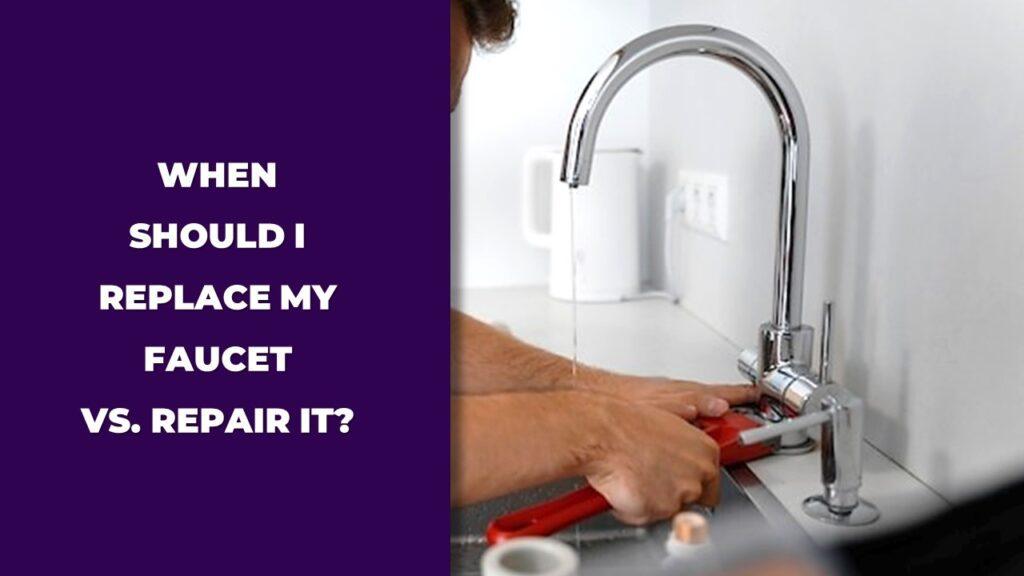
If your faucet drips once in a while or the handle feels a bit loose, a quick repair can often sort it out. That might mean tightening a part or swapping out a small piece. But if you keep fixing the same leak over and over, or if the faucet looks worn and crusty, it’s probably time to replace it. Old faucets can waste water, drive up your bills, and just make your sink look tired.
So, how do you know when to fix it and when to toss it out? We’ll walk through the signs that say repair is enough, when a new faucet makes more sense, and what to watch for.
Should You Repair or Replace a Faucet?
If your faucet drips once in a while, has a loose handle, or a clogged aerator, you can usually fix it without much trouble. A quick repair can make it work like new again. But if the faucet leaks often, looks worn out, or is more than 10 years old, replacing it might be the smarter choice. It saves water, lowers your bills, and helps avoid bigger plumbing problems.
So, how do you know what’s best? It depends on three things: the problem you’re facing, the faucet’s age, and how many times you’ve already fixed it. For example, a small leak that just showed up is probably fixable; a faucet that’s been repaired three or four times already is a different story. Time to cut your losses and get a new one. Let’s break it down so you can make the right call.
When to Repair Your Faucet: Signs, Scenarios, and Costs
If your faucet has a one-time issue or a minor problem, repairing it can save you money and keep it running for years. Many faucet problems are small and easy to handle, like worn-out washers or a clogged aerator. These fixes are simple, fast, and often don’t need a plumber. But not every problem is worth patching up, and repair costs can add up. Let’s look at the details.
What Problems Can Be Fixed Easily?
Some faucet problems are no big deal. You can fix them in less than an hour with basic tools from your local hardware store. Here are the most common easy-fix issues:
- Small Drips or Leaks That Just Started: If your faucet just started leaking, it’s often a simple fix. It could be a loose connection, a worn washer, or a tiny part that’s easy to replace.
- Loose Handles or Spouts: A handle or spout that wobbles can usually be tightened from underneath the sink or by adjusting a small screw.
- Low Water Pressure: If your faucet is flowing slowly, it might be a clogged aerator. Unscrew it, rinse out the debris, and you’re good to go.
- Water Spots or Scratches: These are cosmetic issues, not functional problems. You can clean them up with vinegar, baking soda, or a bit of polish.
- Squeaky or Stiff Handles: Often caused by dried-out parts or buildup; a bit of plumber’s grease can make it smooth again.
- Leaks Under the Sink: Sometimes, the faucet connections under the sink get loose. Tightening the nuts with a wrench usually solves it.
These repairs don’t cost much, and you can often handle them yourself. They’re quick wins that keep your faucet in good shape.
When It’s Worth Repairing
Repairing makes sense when the faucet still has life left in it, and the problem isn’t a repeat issue. Here’s when a repair is a good idea:
- Faucet Age: If your faucet is less than 10 years old, it probably has some years left. Newer models are built to last, and parts are easier to find.
- Problem History: If this is the first or second issue, it’s worth fixing, but if the faucet has needed repairs every few months, it might be time to stop sinking money into it.
- Parts Are Available: Some brands make it easy to find cartridges, washers, and seals. If you can find the parts, repairing is often cheaper.
- Style and Fit: If the faucet matches your kitchen or bathroom perfectly, and you don’t want a new look, repairing can save the hassle of finding a replacement.
- Cost Check: A good rule of thumb: if the repair costs less than 30% of a new faucet, go for the fix. If it’s more, think about replacing it instead.
Cost of Faucet Repairs
Repair costs can vary, but here’s a ballpark breakdown based on real estimates:
- Basic DIY Fixes: Replacing a washer, cleaning an aerator, or tightening a loose part can cost $10 to $50 if you do it yourself.
- Cartridge Replacement: For single-handle faucets, cartridges usually run $40 to $100; if you call a plumber, expect to add $150 to $300 in labor.
- Professional Repairs: If you hire a plumber for a leak or valve issue, you’ll likely pay $150 to $400, depending on the job and where you live.
- Hidden Costs: Some older faucets have hard-to-find parts. If your faucet is outdated, even a simple repair might cost more or take longer because parts aren’t available.
Bottom line, small fixes are cheap; bigger repairs can add up fast. If you’ve already spent a couple hun ofdred dollars trying to fix a faucet, it might be smarter to replace it and stop throwing money down the drain.
When to Replace Your Faucet: Warning Signs You Can’t Ignore
If your faucet is leaking all the time, looks worn out, or just isn’t working like it used to, it’s probably time for a replacement. A new faucet can stop water waste, lower your bills, and save you the headache of constant repairs. Don’t wait until a small problem turns into a big one—knowing the right signs can help you avoid a plumbing disaster.
Sometimes it’s tempting to patch up the same faucet again and again, but that can cost more in the long run. Let’s break down the red flags you should watch for, how a faucet’s age plays into it, and how the cost of repairs stacks up against replacement.
Red Flags That Mean It’s Time for a New Faucet
Some faucet problems are small, but others are a big flashing sign that it’s time for a replacement. Here are the clear signs you shouldn’t ignore:
- Leaks That Won’t Quit: If you’ve fixed it more than once and it still leaks, it’s not just a small problem anymore.
- Visible Corrosion or Rust: A faucet covered in rust, mineral deposits, or corrosion is a faucet on borrowed time.
- Spitting or Uneven Water Flow: If water sprays everywhere or comes out in spurts, it often means internal damage you can’t just patch up.
- Loose or Wobbly Handles That Can’t Be Tightened: A faucet that feels like it’s about to fall apart isn’t safe or reliable.
- Water Smells or Tastes Odd: If your water smells metallic or has a strange taste only from one faucet, it could be from the inside of the faucet breaking down.
If you spot any of these, it’s time to stop fixing and start shopping for a new faucet.
Faucet Age and Efficiency: Does It Make Sense to Replace?
Age matters. Most faucets last about 10 to 15 years with regular use. But even if your faucet still looks okay, an old faucet can waste a lot of water and energy compared to newer models. Older faucets often flow at 3–5 gallons per minute, while newer, water-saving faucets use just 1.5 to 2.5 gallons per minute. That difference adds up on your water bill.
If your faucet is older than 10 years, makes strange sounds, leaks often, or just feels outdated, replacing it with a modern, efficient model might save you more money and hassle in the long run.
Repair vs. Replace: Cost Breakdown
Here’s a simple breakdown to help you decide whether to repair or replace:
| Factor | Repair | Replace |
| Typical Cost | $100–$400+ | $50–$500+ (plus installation) |
| Lifespan Impact | Short-term fix | Resets lifespan (10–15 years) |
| Water Savings | Minimal | 20–40% with a modern faucet |
| Time & Effort | Quick fix, DIY possible | Plumber needed, longer downtime |
If your repair bill is starting to creep up towards the cost of a new faucet, it might make sense to stop throwing money at it and invest in a replacement.
Factors to Consider Before Deciding
If you’re stuck between repairing and replacing, here’s what to think about first:
- How Old Is the Faucet? If it’s over 10 years old, it’s probably due for a replacement.
- How Many Times Has It Been Repaired? If you’ve already fixed it once or twice, it might be okay to try again. But if you’re on your third or fourth repair, a new faucet is the better bet.
- Are Replacement Parts Available? Some faucet models are easy to fix, while others have rare parts that are hard to find.
- Is the Style Still Right for Your Space? If you’re updating your kitchen or bathroom, it’s a good time to replace the faucet to match the new look.
- Are You Wasting Water? Older faucets can waste gallons every day. If your water bill is going up, a new water-efficient faucet can help.
- How Much Are You Willing to Spend Long Term? A repair might be cheaper today, but if it keeps breaking, you’ll pay more in the long run.
Pro Tips for Faucet Maintenance
A little faucet care goes a long way. Clean the aerator every few months, check for leaks, tighten loose handles, and use plumber’s grease if the handle feels stiff. Avoid harsh cleaners that damage the finish, and flush the faucet if you have hard water. Replacing washers or seals when they wear out can stop small leaks before they become big problems. Regular maintenance helps your faucet last longer, saves water, and cuts down on costly repairs.
It’s easy to forget about your faucet until something goes wrong. But spending a few minutes now and then can save you a lot of trouble later. When you clean the aerator, you’re helping water flow the way it should. If you spot a tiny drip, don’t brush it off—fixing it early can save your cabinet from water damage. Loose handles? A quick twist with a screwdriver keeps things tight. If the faucet feels sticky, a bit of plumber’s grease can make it smooth again. Hard water causing buildup? Just flush it out every so often. And if you see a leak, check the washers or seals—those little parts often wear out first. Taking care of these small things means your faucet will stay in good shape for years, and you won’t be stuck paying for big repairs down the line.
Final Thoughts
Your faucet might not seem like a big deal, but it sure is when it stops working. It’s one of those things you don’t think much about until you’re standing there, water dripping into the sink, wondering if it’s time to fix it or toss it. The thing is, a small drip or a loose handle? That’s usually a quick fix. But if your faucet keeps leaking no matter what you do, or it’s looking old and beat-up, replacing it might save you more money and trouble in the long run.
Think about how old it is. If it’s been in your kitchen or bathroom for more than 10 years, it’s probably ready for retirement. And if you’ve already spent money on a couple of repairs, ask yourself—am I fixing the same problem over and over? If the answer is yes, it’s time to stop pouring cash into it and just get a new one.
The bottom line? Listen to your faucet. A little leak isn’t the end of the world, but it’s not something to ignore either. If it’s acting up, figure out what’s going on and make the smart choice—fix it if it’s a one-off, or replace it if it keeps giving you trouble. Either way, you’ll save water, money, and a lot of headaches.
Related FAQs
How long does a faucet typically last?
Most faucets last around 10 to 20 years, but it depends on how often you use it, how hard your water is, and how well you take care of it.
Can I repair a faucet myself?
Absolutely. If it’s a small leak, a clogged aerator, or a loose handle, you can usually handle it with basic tools. Bigger problems, like cracked parts or major leaks, might need a plumber’s help.
How do I know if my faucet is wasting water?
Keep an eye on your water bill. If it’s higher than usual, or you hear a drip that doesn’t stop, your faucet might be the culprit. You can also test the flow by filling a bucket and timing how long it takes.
Should I upgrade to a water-saving faucet?
Definitely. Newer faucets are designed to use less water without losing pressure. They can save you money on your water bill and help cut down on waste, too.

Dylan Foster is a family man with years of hands-on experience in plumbing, household maintenance, and fixing everyday issues around the home. A former plumber, Dylan knows what it’s like to deal with tricky leaks, worn-out parts, and all the little problems that pop up in a house. From plumbing repairs to kitchen fixes and garden hose setups, he’s done it all. Dylan shares real-world solutions to help others keep their homes running smoothly and avoid costly mistakes.




